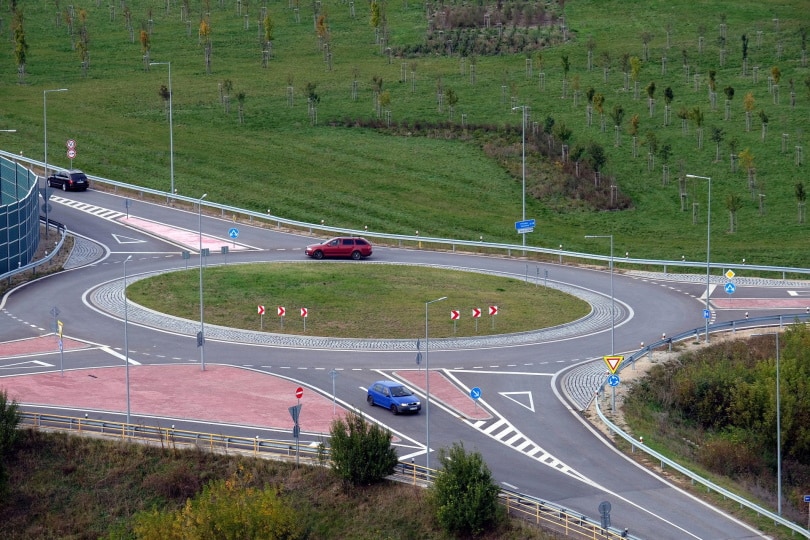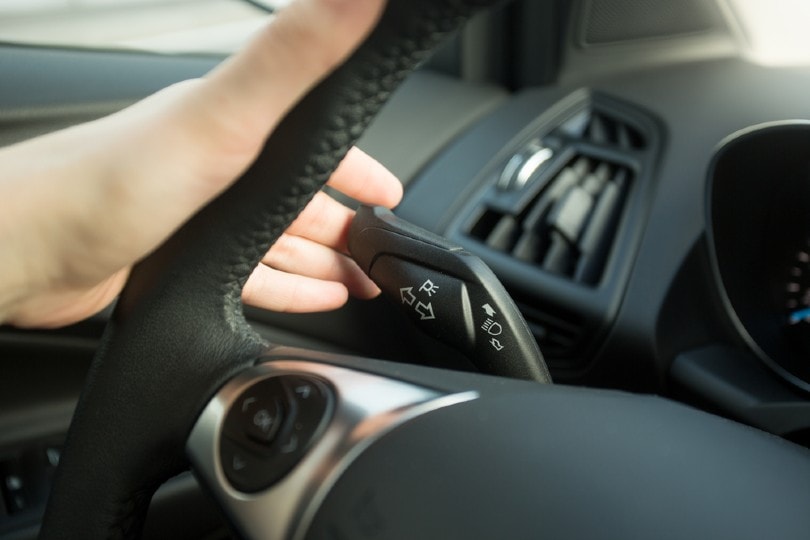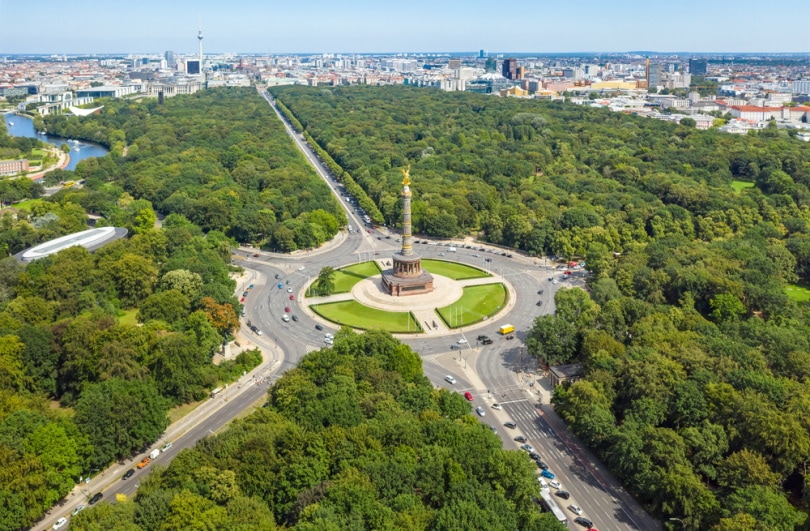What is a Roundabout? Pros, Cons & Rules
-

- Last updated:

A roundabout is a circular intersection that is common around the world. Even though there are no traffic lights or signals in the roundabout, this invention helped improve traffic flow and reduced blocked-up roads and intersections.
Even though many people dislike the roundabout or even fear it, this remarkable invention has simple rules to keep drivers and pedestrians safe. By the end of this article, we hope to break this myth of roundabouts being scary and hope to provide you with the confidence you need to face them. Continue reading to learn how to stay safe when driving in a roundabout.
The First Roundabout Design
The roundabout was introduced in 1905 in the United States, and the starter design had some flaws. The main principle of using a circular intersection was to prioritize all those vehicles entering or about to enter the roundabout. This meant a higher traffic volume, so an overall impression of the first roundabout was negative.
The modern circular intersection was only developed in the 1960s, which has one primary principle, entering vehicles had to give way to the circulating traffic. This design was the ancestor of the modern-day roundabout as we know it.
The 7 Roundabout Rules
The simplest way to imagine a roundabout is to imagine a regular intersection. If you enter the street with the right of passage, you will wait until the traffic is clear and then enter safely and continue your way. It works the same with circular intersections. There are a few rules to a functioning roundabout that all drivers should know. By learning the vision behind a circular roundabout, you will ensure your safety and the safety of all participants in the traffic.
1. Decide which exit to take in time
This is the first step to maneuvering a roundabout correctly, and it should be done way ahead of time before you approach the intersection. It is crucial to decide which exit to take so you do not cause an unnecessary traffic jam in the middle of the roundabout.

2. Adjust your speed to fit into the traffic conditions
As you approach the roundabout, start slowly adjusting your speed. If required, you need to have enough time to stop at the roundabout’s entrance. The vehicles already circulating inside the intersection will not be aware of your speed and movement, so if you aggressively enter the roundabout, they won’t be able to stop in time.
3. Yield to all vehicles that are already in the roundabout
Anytime you find yourself entering the roundabout, make sure to stop or slow down, look to your left, and pass through all the vehicles that are inside. As mentioned above, the cars already circulating in the roundabout have more priority than those entering. This ensures no traffic jam is created and the roundabout is always open and circulating correctly.

4. Enter the correct lane
Once you have a clear way, enter the correct lane. This means the outer lane for the first two exits, while the inner lane is for taking a third or any subsequent exit. This way, you ensure the flow of traffic inside the roundabout. It is essential to follow these rules to prevent the clutter of only one lane.
5. Make sure to use signaling
Signaling may be one of the essential rules of a roundabout. When entering a roundabout, it is important to signal other drivers in time when you are planning to exit. It is also important not to signal too soon as this may cause further confusion. It would be best to turn on the signal moments before you reach your exit and then turn it off once you are out of the roundabout.

6. Be cautious of other drivers that don’t use signaling
While most drivers know how and when to use a signal, many reckless and arrogant drivers don’t think this habit is that important. Using the signal correctly is the only way to let other participants on the roundabout know your intentions. If a driver signals the wrong way or at the wrong time, it could easily cause a minor collision. Be aware of these drivers, as you will have to maneuver your way out of a tricky situation if something like this happens. You need to stay aware of everything happening around you and be ready to act fast.
7. Exit the roundabout while being careful of drivers on your right
The last step is to exit the roundabout correctly. It may sound easy, but there are tricky situations that may happen here as well. If you have entered the inner lane and are about to exit, be aware of all other drivers driving in the outer lane and using the same exit as you. They will have priority to exit first, and you will need to be cautious of these drivers.

What are the Different Types of Roundabouts?
There are a few different roundabouts around the world. The designs of these circular intersections will depend on the need of a particular city, the volume of traffic, and the roundabout location. When you consider all these factors, there are two basic types of roundabouts:
- Single-lane roundabout
- Multi-lane roundabout
The way these two roundabouts function is entirely the same, with the only difference being multiple lanes in one roundabout. That means you would need to stay in the correct lane from the moment you enter the roundabout until you exit it.
Typical Size of a Roundabout
The size of a roundabout can be affected by many different factors. The main factors that come into account when designing a roundabout are the volume of traffic it has to handle, the size of the surrounding area, the number of surrounding roads, and the average speed on those roads.
The most common size of a single-lane roundabout is usually between 100 and 125 feet in diameter. When it comes to multi-lane roundabouts, they take up much more space. They are generally up to 150 feet in diameter, but there are much bigger roundabouts found worldwide too.

Advantages of Roundabouts
Since the roundabout was invented, they brought many beneficial aspects to the functioning of traffic. Roundabouts reduce the number of crashes and promote faster and more efficient movement in traffic. The benefits that roundabouts bring are broad, including:
- Much less waiting in traffic
- Fewer traffic jams
- Reduces fuel consumption and pollution
- About 90% fewer fatal accidents
- 75% fewer injuries in traffic
- Up to 40% fewer pedestrian crashes

Disadvantages of Roundabouts
While roundabouts are incredibly beneficial, some people believe they are not safe enough. Circular intersections have reduced car accidents and crashes, but when you look at the way they work, many risks can lead to a collision, and those mainly come from drivers that are unaware of the rules in the roundabout. Some of the drawbacks that roundabouts have include:
- Narrow bicycle lanes
- Confusion in traffic
- Uncertainty of when to yield
- Irresponsible drivers may cause disruption
- Greater risk of collision
Conclusion
In this article, you can find a step-by-step guide on entering and exiting the roundabout correctly. Once you learn the basic rules that apply to a circular intersection, you will be able to use them effortlessly and safely. All the myths of a roundabout being unsafe and scary will break once you understand and apply all the rules that we’ve listed. You can always come back to this article and remind yourself of the principles that apply to the correct functioning of roundabouts.
Featured Image Credit: Piqsels
Contents


